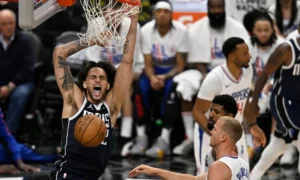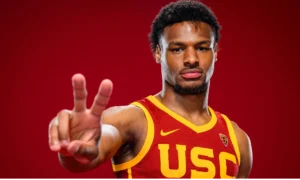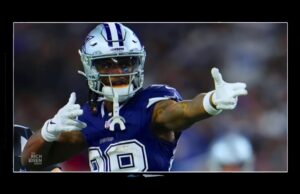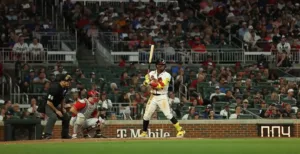Basketball Positions Explained
Basketball is a team sport with five players on each team, each with specific roles and responsibilities. These roles are known as basketball positions, and each has a unique set of skills, playing styles, and focus areas on the basketball court.

Basketball is a team sport with five players on each team, each with specific roles and responsibilities. These roles are known as basketball positions, and each has a unique set of skills, playing styles, and focus areas on the basketball court.
Why Basketball Positions Are Important?
Basketball positions provide a framework for understanding players’ key roles and responsibilities on the court. They help teams strategize and develop compelling gameplay, allow players to specialize and maximize their skills, and promote teamwork and collaboration. Overall, understanding positions is of utmost importance in basketball.
How Many Basketball Positions Are There?
There are five main and four hybrid positions in basketball:
- Point Guard
- Shooting Guard
- Small Forward
- Power Forward
- Center
- Combo Guard
- Stretch Four
- Swingman
- Point Forward
Let’s discuss them one by one in detail.
5 Main Positions in Basketball
The five basketball positions are:
1. Point Guard
A point guard runs the team’s offense and sets up plays. They are often called the “floor general” because they act as a leader on the court, directing their teammates and making strategic decisions. A point guard is often the shortest player on the team but possesses excellent decision-making skills and a high basketball IQ.
Skills and attributes required for a point guard:
Court vision: Point guards must have exceptional court vision to see the entire court and quickly assess the best play or pass to make.
Passing ability: A great point guard must have excellent passing skills to create opportunities for their teammates. They should be able to make accurate and timely passes, both in half-court and transition situations.
Ball-handling: Point guards need to have exceptional ball-handling skills to navigate through defensive pressure and maintain control of the ball.
Basketball IQ: As the floor general, point guards must have a high basketball IQ. This means understanding the game’s tactical aspects, such as reading defenses, recognizing scoring opportunities, and knowing when to make certain plays.
Leadership: Point guards must be effective leaders on and off the court. They should be able to communicate well with their teammates, motivate them, and make crucial decisions during games.
Quickness and agility: Point guards often face defensive pressure and need to be quick and agile to navigate around defenders and create scoring opportunities.
Notable point guards in basketball history:
Magic Johnson: Johnson is considered one of the greatest point guards ever. He played for the Los Angeles Lakers and was known for his exceptional passing ability, court vision, and leadership skills.
John Stockton: Stockton played for the Utah Jazz and is the NBA’s all-time leader in assists and steals. He was known for his consistency, basketball IQ, and exceptional passing ability.
Isiah Thomas: Thomas played for the Detroit Pistons and led them to two NBA championships. He was known for his toughness, scoring ability, and leadership qualities.
Steve Nash: Nash, a two-time NBA MVP, played for the Phoenix Suns. He was known for his exceptional passing skills, court vision, and ability to control the game’s tempo.
Chris Paul: Paul is considered one of the top point guards of his generation. He has played for several teams, including the New Orleans Hornets, Los Angeles Clippers, and Phoenix Suns. Paul is known for his leadership, ball-handling, and playmaking abilities.
ALSO READ: Hardest Position in Basketball?
2. Shooting Guard
The shooting guard is usually played by a player who is an offensive threat and excels at shooting from the perimeter. The shooting guard is typically positioned between the point guard and small forward. They are responsible for scoring points, creating plays, and guarding the opponent’s shooting guard.
Skills and attributes required for a shooting guard:
Shooting Accuracy: The ability to make shots consistently from various positions on the court is crucial for a shooting guard.
Scoring Ability: A shooting guard should be able to create their shot, drive to the basket, and score through a combination of jump shots, layups, and three-pointers.
Ball Handling: Good ball-handling skills are vital for a shooting guard to navigate defenses and create scoring opportunities for themselves and their teammates.
Perimeter Defense: Being able to guard the opponent’s shooting guard effectively is a key attribute of a shooting guard. Quick footwork, lateral movement, and defensive awareness are necessary to limit the opponent’s scoring.
Also Read: Best Basketball Shoes for Shooting Guards
Basketball IQ: A high basketball IQ helps in decision-making, understanding plays, and finding open teammates.
Agility and Quickness: Shooting guards must move quickly, change direction, and react swiftly to create scoring opportunities or defend against opponents.
Famous shooting guards in basketball history:
Michael Jordan: Often considered the greatest basketball player of all time, Jordan played shooting guard for the Chicago Bulls and earned six NBA championships.
Kobe Bryant: Bryant, who played for the Los Angeles Lakers, was known for his scoring ability and competitive spirit. He won five NBA championships during his career.
Dwyane Wade: Wade played for the Miami Heat and was key in their three NBA championship wins. He excelled at scoring, defense, and leadership.
Ray Allen: Known for his incredible shooting skills, he set the record for most three-pointers in the history of the NBA. He played for various teams, including the Milwaukee Bucks and Boston Celtics.
James Harden: Currently playing for the Brooklyn Nets, Harden is known for his scoring ability, particularly through his three-point shooting and driving to the basket. He has been awarded the NBA scoring title multiple times.
Reggie Miller: Miller played for the Indiana Pacers and was known for his clutch shooting and ability to score points rapidly. He is considered one of the best three-point shooters in NBA history.
3. Small Forward
The small forward, also known as the “3” position, is typically one of the five players on a basketball team. They are usually the most versatile players on the court and are responsible for both scoring and defending. A small forward plays various roles, depending on the team’s strategy and the player’s skills, but generally, they are expected to contribute in all aspects of the game.
Skills and attributes required for a small forward:
To be successful as a small forward, players need a combination of skills and attributes. They should have good shooting ability from mid-range and beyond the arc. They should also have strong ball-handling skills and the ability to drive to the basket.
Small forwards usually are versatile defenders, capable of guarding multiple positions and contributing to team defense. They should have good court vision and passing skills, as they often initiate plays and create opportunities for their teammates. Moreover, small forwards must have athleticism, agility, and the ability to rebound effectively, as they often play a crucial role in the team’s rebounding efforts.
Famous small forwards in basketball history:
There have been several famous small forwards in basketball history. Some notable examples include:
Larry Bird: Bird is widely regarded as one of the greatest small forwards ever. He played for the Boston Celtics from 1979 to 1992 and won three NBA championships. Bird was known for his exceptional shooting ability, basketball IQ, and competitiveness.
LeBron James: James is often considered one of the best basketball players, regardless of position. He has played for multiple teams, including the Cleveland Cavaliers and Miami Heat. James has won four NBA championships and has been named NBA Finals MVP four times. He possesses a unique combination of size, athleticism, and basketball skills, making him one of history’s most dominant small forwards.
Scottie Pippen: Pippen played alongside Michael Jordan for the Chicago Bulls during their dominant run in the 1990s. He won six NBA championships with the Bulls and was known for his versatility, exceptional defense, and ability to contribute in multiple ways. Pippen was an integral part of the Bulls’ success and is considered one of the best small forwards in the history of the NBA.
Kevin Durant: Durant is an exceptional scorer and shooter, known for his ability to score from anywhere on the court. He has won two NBA championships and has been named NBA Finals MVP twice. Durant’s size, shooting ability, and versatility have made him one of the most prolific small forwards in the modern era.
These are just a few examples of famous small forwards, but many other great players have been in this position throughout basketball history.
ALSO READ: Is Nike Court Vision Good for Basketball?
4. Power Forward
The power forward, often referred to as the “4” position, is one of the five positions in basketball. The power forward typically plays in the frontcourt and has a significant offensive and defensive role. They are responsible for scoring points, rebounding, defending the opposing team’s frontcourt players, and setting screens to create scoring opportunities for their teammates.
Skills and attributes required for a power forward:
Scoring ability: A power forward must have a diverse scoring skill set, including the ability to shoot from mid-range, finish at the rim, and occasionally stretch the floor with three-point shooting.
Rebounding: Strong rebounding skills are crucial for a power forward, as they need to secure both offensive and defensive rebounds to give their team more scoring opportunities.
Size and strength: Power forwards are usually one of the tallest players on the team, often with the ability to play physically and use their strength in the post area.
Defensive versatility: Being able to guard different positions, from smaller guards to larger centers, is an important attribute for a power forward.
Intangibles: Mental toughness, leadership skills, and the ability to thrive in high-pressure situations are valuable qualities for a power forward.
Famous power forwards in basketball history:
Tim Duncan: Known for his fundamental skills, leadership, and exceptional basketball IQ, Tim Duncan is considered one of the best power forwards of all time. He won five NBA championships with the San Antonio Spurs.
Karl Malone: A two-time NBA MVP and one of the most prolific scorers in NBA history, Karl Malone is widely regarded as one of the greatest power forwards. He spent most of his career with the Utah Jazz.
Dirk Nowitzki: Known for his unique combination of shooting skills and athleticism, Dirk Nowitzki revolutionized the power forward position. He led the Dallas Mavericks to an NBA championship 2011 and is regarded as one of the greatest foreign players in the history of the NBA.
Kevin Garnett: Renowned for his intensity, defensive prowess, and versatility, Kevin Garnett had a successful career spanning over 20 seasons. He won an NBA title with the Boston Celtics in 2008 and is regarded as one of the best power forwards of his era.
Charles Barkley: A dominant force during his time, Charles Barkley was known for his exceptional rebounding ability and scoring versatility. He won the NBA MVP award in 1993 and is widely regarded as one of the best power forwards ever.
5. Center
The center is one of the five positions in basketball. Typically, Centers are the tallest players on the team, and they play close to the basket. The center’s role is to score points in the paint, rebound, and block shots. They are also responsible for setting screens for their teammates and defending the paint.
Also Read: Best Basketball Shoes for Centers in 2023
Skills and attributes required for a center
The following are some of the skills and attributes required for a center:
Height: Centers are typically the tallest players on the team. This gives them an advantage in rebounding and blocking shots.
Strength: Centers need to be strong in order to defend against other centers and rebound effectively.
Post moves: Centers need to have a variety of post moves to score points in the paint. These moves can include drop steps, pivots, and hook shots.
Rebounding: Centers need to be good rebounders in order to help their team control the tempo of the game.
Shot blocking: Centers need to be good shot blockers in order to protect their team’s basket.
Famous centers in basketball history
Some of the most famous centers in basketball history include:
Wilt Chamberlain: Chamberlain is widely considered to be the greatest center of all time. He was a dominant force on both ends of the court, averaging 50.4 points per game in 1961-62.
Bill Russell: Russell won 11 NBA championships with the Boston Celtics, more than any other player in history. He was a dominant defensive player, averaging 22.9 rebounds per game.
Kareem Abdul-Jabbar: Abdul-Jabbar is the NBA’s all-time leading scorer, and he won six NBA championships with the Milwaukee Bucks and Los Angeles Lakers. He was a versatile scorer who could shoot from inside and outside.
Shaquille O’Neal: O’Neal was one of the most dominant centers in NBA history. He won four NBA championships with the Los Angeles Lakers and was a two-time NBA MVP. He was a powerful scorer in the paint and a good rebounder and shot blocker.
Hakeem Olajuwon: Olajuwon was a dominant center in the 1990s. He won two NBA championships with the Houston Rockets and was a two-time NBA MVP. He was a skilled post scorer, and he was also a good rebounder and shot blocker.
Hybrid Positions
There are four hybrid positions in basketball:
6. Combo Guard
A combo guard is a player who can play both the point guard and shooting guard positions. They are typically good at both ball handling and scoring. Combo guards are often used to create scoring opportunities for their teammates, and they can also take over games as scorers themselves.
Skills and attributes required for a combo guard
The following are some of the skills and attributes required for a combo guard:
Ball-handling: Combo guards need to be a good ball handler to create scoring opportunities for themselves and their teammates. They need to be able to dribble through traffic and create space to shoot or pass.
Shooting: Combo guards need to be good shooters to be effective. They need to be able to shoot from both inside and outside, and they need to be able to make shots in pressure situations.
Passing: Combo guards need to be good passers to be effective. They need to be able to see the court and make accurate passes to their teammates.
Defense: Combo guards need to be good defenders to be effective. They need to be able to guard both the point guard and shooting guard positions, and they need to be able to disrupt the opposing team’s offense.
Examples of famous combo guards in basketball history
Some of the most famous combo guards in basketball history include:
Allen Iverson: Iverson was among the most popular players in the history of the NBA. He was a dynamic scorer and a creative ball-handler. He averaged 27.2 points per game for his career.
Michael Jordan: Jordan is widely considered to be the greatest basketball player of all time. He was a dominant scorer and a lockdown defender. He averaged 30.1 points per game for his career.
Kobe Bryant: Bryant was one of the most prolific scorers in the history of the NBA. He was a two-time NBA MVP and five-time NBA champion. He averaged 25.0 points per game for his career.
Dwayne Wade: Wade was among the most exciting players in the history of the NBA. He was a dynamic scorer and a lockdown defender. He won three NBA championships with the Miami Heat.
James Harden: Harden is one of the most prolific scorers in NBA history. He is a two-time NBA MVP and three-time scoring champion. He is averaging 29.3 points per game for his career.
These are just a few of the many great combo guards who have played basketball throughout history. The combo guard position is one of the most versatile positions in basketball, and it requires a unique combination of skills and attributes.
7. Stretch Four
A stretch four is a power forward who can shoot the three-pointer. They are typically used to space the floor and create scoring opportunities for their teammates. Stretch fours can also be effective in pick-and-pop situations, where they can roll to the basket or pop out for a three-pointer.
Skills and attributes required for a stretch four
The following are some of the skills and attributes required for a stretch four:
Shooting: Stretch fours need to be good shooters to be effective. They need to be able to shoot from three-point range consistently, and they need to be able to make shots in pressure situations.
Ball-handling: Stretch fours need to be able to handle the ball to create their own shot. They need to be able to dribble past defenders and create space to shoot or pass.
Passing: Stretch fours need to be able to pass to be effective. They need to be able to see the court and make accurate passes to their teammates.
Defense: Stretch fours need to be good defenders to be effective. They need to be able to guard both the power forward and small forward positions, and they need to be able to protect the rim.
Famous stretch fours in basketball history
Some of the most famous stretch fours in basketball history include:
Dirk Nowitzki: Nowitzki is one of the greatest shooters in NBA history. He was a two-time NBA MVP and one-time NBA champion. He averaged 24.3 points per game for his career.
Kevin Durant: Durant is one of the greatest scorers in NBA history. He is a two-time NBA MVP and two-time NBA champion. He is averaging 27.1 points per game for his career.
Pau Gasol: Gasol is a two-time NBA champion and a four-time All-Star. He was a versatile player who could shoot from three-point range, pass the ball, and rebound.
LaMarcus Aldridge: Aldridge is a seven-time All-Star known for his mid-range shooting and post-up game. He is also a good passer and rebounder.
Kristaps Porzingis: Porzingis is a 7’3″ stretch four known for his shooting and shot-blocking ability. He is still developing his game, but he has the potential to be one of the best stretch fours in the NBA.
8. Swingman
A swingman is a player who can play both the shooting guard and small forward positions. They are typically good at both scoring and defending. Swingmen are often used to create scoring opportunities for their teammates, and they can also take over games as scorers themselves.
Skills and attributes required for a swingman
The following are some of the skills and attributes required for a swingman:
Shooting: Swingmen need to be good shooters to be effective. They need to be able to shoot from both inside and outside, and they need to be able to make shots in pressure situations.
Ball-handling: Swingmen need to be able to handle the ball to create their shot. They need to dribble past defenders and create space to shoot or pass.
Passing: Swingmen need to be able to pass to be effective. They need to be able to see the court and make accurate passes to their teammates.
Defense: Swingmen need to be good defenders to be effective. They need to be able to guard both the shooting guard and small forward positions, and they need to be able to disrupt the opposing team’s offense.
Famous swingmen in basketball history
Some of the most famous swingmen in basketball history include:
LeBron James: James is widely considered to be the greatest basketball player of all time. He is a four-time NBA MVP and four-time NBA champion. He is a versatile player who can score from anywhere on the court, rebound, and pass.
Michael Jordan: Jordan is widely considered to be the greatest basketball player of all time. He was a dominant scorer and a lockdown defender. He averaged 30.1 points per game for his career.
Kobe Bryant: Bryant was one of the most prolific scorers in the history of the NBA. He was a two-time NBA MVP.
9. Point Forward
A point forward is a player who plays the power forward position, but they also have the ball-handling and passing skills of a point guard. They are often used to create scoring opportunities for their teammates, and they can also take over games as scorers themselves.
Skills and attributes required for a point forward
The following are some of the skills and attributes required for a point forward:
Ball-handling: Point forwards need to be good ball-handlers to create scoring opportunities for themselves and their teammates. They need to be able to dribble through traffic and create space to shoot or pass.
Passing: Point forwards need to be good passers to be effective. They need to see the court and make accurate passes to their teammates.
Shooting: Point forwards need to be good shooters in order to be effective. They need to be able to shoot from both inside and outside, and they need to be able to make shots in pressure situations.
Rebounding: Point forwards need to be good rebounders in order to help their team control the tempo of the game.
Defense: Point forwards need to be good defenders in order to be effective. They need to be able to guard both the power forward and small forward positions, and they need to be able to disrupt the opposing team’s offense.
Famous Point Forwards in basketball history
Some of the most famous point forwards in basketball history include:
LeBron James: James is widely considered to be the greatest basketball player of all time. He is a four-time NBA MVP and four-time NBA champion. He is a versatile player who can score from anywhere on the court, rebound, and pass.
Larry Bird: Bird was a dominant player in the 1980s. He was a two-time NBA MVP and three-time NBA champion. He was a gifted passer and shooter, and he was also a good rebounder.
Kevin Garnett: Garnett was a dominant player in the 1990s and 2000s. He was a one-time NBA MVP and a two-time NBA champion. He was a versatile player who could score from anywhere on the court, rebound, and defend.
Pau Gasol: Gasol is a two-time NBA champion and a four-time All-Star. He was a versatile player who could shoot from three-point range, pass the ball, and rebound.
Point forwards are versatile type of player who can be a valuable asset to any team. They can play multiple positions and contribute in a variety of ways.
Final Word
The different positions in basketball have a unique impact on team dynamics and strategy. For example, point guards are typically responsible for running the offense and creating scoring opportunities for their teammates. This means that they need to be good ball-handlers, passers, and decision-makers.
Shooting guards are typically responsible for scoring points, so they need to be good shooters and scorers. Power forwards are typically responsible for rebounding and scoring points in the paint, so they must be good rebounders and post-scorers. Small forwards are typically responsible for scoring points and defending multiple positions, so they must be good shooters, defenders, and ball-handlers.
Centers are typically responsible for rebounding, blocking shots, and scoring points in the paint, so they need to be good rebounders, shot blockers, and post scorers.
FAQs About Positions in Basketball
#1. Which basketball position scores the most?
I have observed that usually, the Small Forward and Shooting Guard positions score the highest scorers.
#2. Is Post a position in basketball?
Yes, Post is a position in basketball. It is the area covered between the free throw line, the baseline, and the Key or the Paint.
#3. Which is the most important basketball position?
The most important position in basketball is a matter of debate, but according to me, the most important position is the Point Guard.
Why?
Because the point guard is typically responsible for running the offense and creating scoring opportunities for their teammates. This means they must be good ball-handlers, passers, and decision-makers.
#4. What are 5 positions in basketball?
The five basic positions in basketball are Point Guard, Shooting Guard, Small Forward, Power Forward, and Center.






